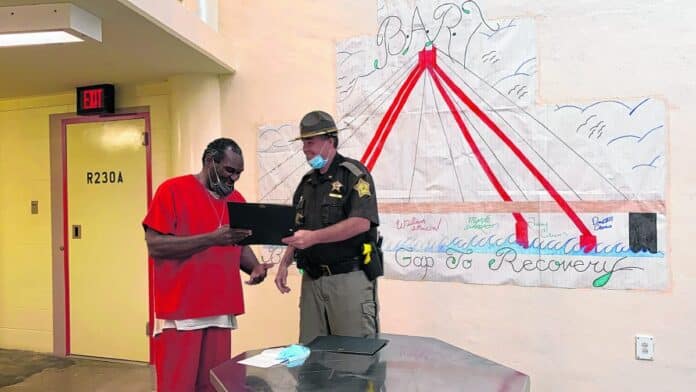
Six men were the first male graduating class for the Bartholomew County Jail’s new six-month addiction treatment program.
Mark Anderson, 49, who is preparing to leave the jail after two years of incarceration, said he feels more optimistic about the future after graduating from the program than he has for several years.
Anderson was joined by Shawn Wainscott, William Streeval, Terry Crum, Dustin Cross and Kenton Wilson in the graduating ceremony Wednesday at the jail, which was attended by county officials and jail personnel.
In addition to the class graduation, after starting a few weeks late, Danielle Hardin was also presented with her graduation certificate Wednesday as well. The other females completed their six-month addiction treatment in early June.
[sc:text-divider text-divider-title=”Story continues below gallery” ]
Scheduled for release Wednesday after completing his sentence for residential entry and invasion of privacy, Anderson said he doesn’t want to find himself behind bars again.
“There’s a point in your life where you just get tired of it,” he said. “You only have a certain amount of time for life, and I have to start living it the right way.”
While admitting long-term addiction therapy is tough at times, Anderson said he found it extremely interesting.
“I learned a lot of stuff that I never knew was going on inside of me,” he said.
The new program
For seven years after a residential drug treatment program in Clarksville closed in 2012, Bartholomew County judges had no way to provide court-ordered residential addiction treatment.
Last summer, the “Recovery Enables a Life for Men” (REALM) program started, which provides comprehensive, evidence-based residential treatment for up to 40 male offenders each year.
The jail’s program, which got underway in January, is a separate entity from REALM and the nine-year-old “Women Recovering with a Purpose”(WRAP) program. Both REALM and WRAP are Community Corrections programs — not part of the jail operations.
Participants in the jail program received group therapy up to three days a week for as long as four hours a day, Bartholomew County Chief Deputy Sheriff Maj. Chris Lane said.
The jail program was created by addiction treatment coordinator Theresa Patton, who explained why the women’s therapy started one month before the men’s program got underway.
“Clinically, women generally have more concerns than men,” she said, adding it can take more time to determine their clinical needs. In the men’s program, Patton said the class is more pragmatic in their thinking and their approach to treatment.
While those receiving residential addiction treatment are kept separated from the general jail population, Patton stressed participation in the addiction treatment program did not shorten a sentence, nor does it “play on any heartstrings” of judges.
So what benefits does completing the six-month program provide? Financially, it would be the same type of treatment at a private rehabilitation facility that could cost up to $120,000, according to the Addiction Center website.
“The inmates are given a chance to get their life back,” Lane said.
The subject matter
During treatment, participants are involved in two different forms of therapy used to treat heroin and methamphetamine addictions, Patton said.
The first is cognitive behavioral therapy, where negative patterns of thought about the self and the world are challenged in order to change unwanted behavior patterns.
The second is called dialectical behavioral therapy, which treats mood disorders and suicidal thoughts, as well as changing behavioral patterns such as self-harm and substance abuse.
Participants also learn about psychodynamic principles, which encourages those suffering from addiction to speak freely about their emotions, desires, and fears.
While understanding therapies and principles help in recovery, program graduates often have a desire to pass on what they learned to others through mentoring or advocating, Patton said.
In order to encourage that, a final exam that every participant takes contains questions pulled from Indiana’s testing for Certified Recovery Coaches, the International Certification and Reciprocity Consortium, the American Society of Addiction Medicine criteria — and even from graduate studies, she said.
“The test is pretty hard,” Patton said. “But I give them a study guide, and we drill down on theory, relapse, and maintenance. I also give them approaches that any private therapist in private practice would be using.”
Nearly all the males at the Bartholomew County Jail scored 80% or higher, with a few scoring over 100% by correctly answering both regular and bonus questions, Lane said.
Positive outlook
After his six month effort in recovery, Anderson says he’s gained the tools and knowledge necessary to stop going through the jail’s revolving door.
He said he’s learned while it’s tempting to put all the blame on drugs, those recovering from addiction must understand some problems were already in their minds.
“If a person doesn’t want to change, you can give them every opportunity and they’ll never change,” Anderson said. “But the vast majority in this program want to change their lives, and are tired of being stuck in the same situations.”
Lane and Anderson credit Patton for creating an effective and successful addiction treatment program. But having options that keep former inmates from returning to the same environment that encourages addiction should have the most positive impact on lives, Anderson said.
Three of the six graduates, including Anderson, have applied for temporary residency in a sober living transitional house for males sponsored by the Alliance for Substance Abuse Progress (ASAP) in Columbus.
If needed, ASAP may also help former inmates fighting addictions get appropriate clothing, sign up for Medicaid, arrange transportation and get their first supply of food, Patton said.
Anderson said he will also seek the alliance’s assistance in trying to secure work. Since he is a certified welder and trained diesel mechanic with extensive construction experience, Anderson believes his in-demand skills will provide him with a fulfilling job.
He expressed “tremendous gratitude” for what the jail and the community have done for him. By providing services to those in recovery, ASAP reduces the frustrations that often prompt relapses back into drug use, Anderson said.
“I’ve never been given these opportunities after being released from jail before,” he said. “Columbus has really stepped up. So many people are now putting forth the effort to help folks like me rehabilitate ourselves, rather than just throwing us behind bars and forgetting about us.”
But completing Patton’s program doesn’t mean an individual in recovery won’t have to keep fighting to stay sober, Lane said.
“Its a continual, lifelong journey to stay the course,” he said.
[sc:pullout-title pullout-title=”About the program ” ][sc:pullout-text-begin]
The addiction treatment program at the Bartholomew County Jail is based on six dimensions designed to create a holistic, biopsychosocial assessment of an individual for planning and treatment across all services and levels of care.
The six dimensions developed by the American Society of Addiction Medicine deal with the exploration of:
- An individual’s past and current experiences of substance use and withdrawal.
- A person’s health history and current physical condition.
- An inmate’s thoughts, emotions and mental health issues.
- An individual’s readiness and interest in changing.
- An inmate’s unique relationship with relapse or continued use or problems.
- A person’s recovery or living situation, and the surrounding people, places or things.
Source: American Society of Addiction Medicine
[sc:pullout-text-end][sc:pullout-title pullout-title=”How inmates are considered for the program” ][sc:pullout-text-begin]
If a Bartholomew County inmate wants to be considered for the jail’s new addiction treatment program, he or she must first write addiction treatment coordinator Theresa Patton to express their interest, she said.
Every person who writes will eventually be interviewed to find out if they are an appropriate fit for the program, Patton said. Clinical work and jail classification, along with several screenings, are used to determine who is admitted, she added.
But those with unrealistic expectations, or who are only trying to be moved out of the general jail population, are generally not considered, Patton said. "They have to want this for their life when they get out of jail," she said.
[sc:pullout-text-end]




